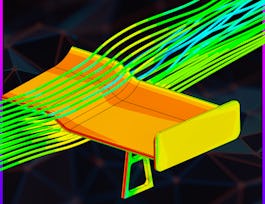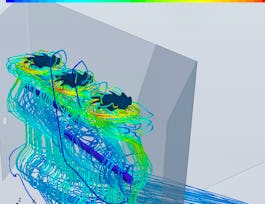If you’re reading this, you’re likely interested in exploring applied computational fluid dynamics (CFD) using the Simcenter STAR-CCM+ software or another CFD tool. This course can be a first step in improving your job performance and furthering your career or educational trajectory.


Applied Computational Fluid Dynamics
Taught in English
Some content may not be translated
12,515 already enrolled
(93 reviews)
Recommended experience
Details to know

Add to your LinkedIn profile
45 quizzes
See how employees at top companies are mastering in-demand skills


Earn a career certificate
Add this credential to your LinkedIn profile, resume, or CV
Share it on social media and in your performance review

There are 5 modules in this course
In Week 1, we'll explore flow in a channel with a semi-circular obstacle on the bottom wall is used to introduce the basic flow models (Euler, Navier-Stokes, and Reynolds-averaged Navier-Stokes equations), the basic features of most flows in engineering applications (boundary layer, shear layer, flow separation, recirculation zone), and the approaches to simulate flows including these phenomena. The distinction between inviscid, laminar, and turbulent flows is explained, as well as how the flow features can be visualized and analyzed and how the knowledge of the flow regime affects the design of the computational grid and the choice of physics models and simulation parameters. Finally, the ways of increasing the efficiency of simulation and the estimation of discretization errors are presented.
What's included
10 videos1 reading9 quizzes2 discussion prompts
In Week 2, we'll explore flows in diffusors and nozzles are studied. They are generic representations of diverging or converging cross-sections of flow paths found in many engineering applications. In both diffusors and nozzles flow separation and recirculations occurs if diverging/converging angles are high enough. In symmetric diffusor geometries the flow is often asymmetric, and in nozzles vena contracta may occur. These phenomena and the evaluation of efficiency of energy conversion as well as the energy losses are explained. The effects of geometrical details (variation of expansion/contraction angle, rounding of corners by different radii) and suction through diffusor walls are also analyzed. Detailed studies of grid-dependence of solutions are performed and the effect of the order of discretization for convection fluxes is analyzed.
What's included
8 videos9 quizzes1 discussion prompt
In Week 3, we'll explore pressure or turbulence induced flow in directions other than the primary flow path are studied. First three-dimensional pressure-driven secondary flows in duct or pipe bends are analyzed in detail, followed by the analysis of turbulence-driven secondary flow in ducts with non-circular cross-sections. The physics behind these phenomena is described and the ways of simulating them are explained. Next, horseshoe vortex and tip vortex flows are analyzed; they too are generic representations of flows resulting in many practical applications with body junctions and free tips. The flow physics, computational details (design of an optimal grid and its local refinement, the choice of physics models and the simulation approach) are explained.
What's included
8 videos9 quizzes1 discussion prompt
In Week 4, we'll explore flows around a circular cylinder at Reynolds numbers between 5 and 5 million are studied. Circular cylinder is a generic representation of a slender body exposed to a cross-flow; such situations are found in many practical applications. Depending on the Reynolds number, the flow may be creeping, steady or unsteady laminar, or turbulent. The flow separation and recirculation can have many different forms, leading to vortex shedding (the von Karman vortex street), transition to turbulence in the wake, in shear layers, or in boundary layers on cylinder surface. Both the drag crises on a cylinder at the critical Reynolds number and the Magnus effect on a rotating cylinder are described. Different techniques of simulating turbulent flows - direct numerical simulation, large-eddy simulation or solution of the Reynolds-averaged Navier-Stokes equations using different turbulence models are presented and it is explained which technique is appropriate for which type of flow.
What's included
8 videos9 quizzes1 discussion prompt
In Week 5, we'll explore heat transfer, including conduction in solids, natural and forced convection in fluids, and conjugate heat transfer. I’ll explain how the heat is transferred between continua at the solid-fluid interface, what is different in laminar and turbulent flows, which properties of a computational grid are desirable at the fluid-solid interface, and why are prism layers at walls important. The difference between stable and unstable stratification in natural convection flows and the importance of accounting for the correct dependence of fluid properties on temperature are emphasized. Finally, it is explained how to optimally simulate simultaneous heat transfer across multiple flow streams separated by solid bodies.
What's included
8 videos9 quizzes1 discussion prompt
Recommended if you're interested in Physics and Astronomy

Coursera Project Network

Coursera Project Network

Coursera Project Network
Why people choose Coursera for their career




Learner reviews
Showing 3 of 93
93 reviews
- 5 stars
81.72%
- 4 stars
15.05%
- 3 stars
2.15%
- 2 stars
0%
- 1 star
1.07%

Open new doors with Coursera Plus
Unlimited access to 7,000+ world-class courses, hands-on projects, and job-ready certificate programs - all included in your subscription
Advance your career with an online degree
Earn a degree from world-class universities - 100% online
Join over 3,400 global companies that choose Coursera for Business
Upskill your employees to excel in the digital economy
Frequently asked questions
Access to lectures and assignments depends on your type of enrollment. If you take a course in audit mode, you will be able to see most course materials for free. To access graded assignments and to earn a Certificate, you will need to purchase the Certificate experience, during or after your audit. If you don't see the audit option:
The course may not offer an audit option. You can try a Free Trial instead, or apply for Financial Aid.
The course may offer 'Full Course, No Certificate' instead. This option lets you see all course materials, submit required assessments, and get a final grade. This also means that you will not be able to purchase a Certificate experience.
When you purchase a Certificate you get access to all course materials, including graded assignments. Upon completing the course, your electronic Certificate will be added to your Accomplishments page - from there, you can print your Certificate or add it to your LinkedIn profile. If you only want to read and view the course content, you can audit the course for free.
You will be eligible for a full refund until two weeks after your payment date, or (for courses that have just launched) until two weeks after the first session of the course begins, whichever is later. You cannot receive a refund once you’ve earned a Course Certificate, even if you complete the course within the two-week refund period. See our full refund policy.




